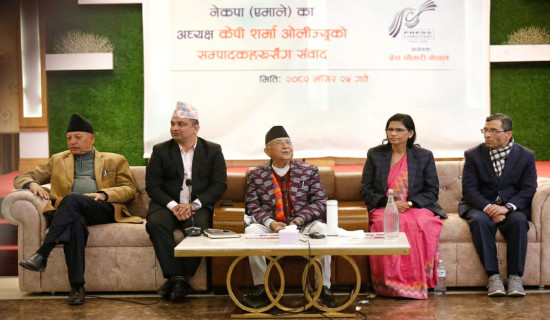- Thursday, 11 December 2025
Wildlife menace common near Shivapuri National Park
Sundarijal, Dec. 25: People living in the vicinity of Shivapuri National Park near the capital city are troubled by wildlife menace. They have been dealing with the problems caused by monkeys and wild boars as the farmers of the remote villages.
Because of the expanding forest cover in buffer zones around Shivapuri Nagarjun National Park, the locals are susceptible to the increasing threats posed by wildlife.
The locals are voicing their frustration over the ongoing wildlife menace and the lack of compensation for loss sustained over the past two years.
Sukamaya Gurung from Bhotechaur-3 in Sindhupalchowk district expressed her panic, "We have not received compensation for the
damages caused to our crops by the wildlife for the last two years. Even if they offer relief, it is insufficient, they provide only up to Rs. 10,000 as a relief, which is not enough to cover the incurred loss."
“I planted maize in 16 ropanis of land last year, wild boars damaged the crops before we could harvest. Leopards and wild bears also invade our homes. The government should provide us with adequate relief, relocate us from the area, or manage the wildlife within the forest,” she said.
Locals cannot go out of their houses alone fearing the leopards and bears, she added.
Meena Gurung of the same ward also has a similar story to share.
Last year, three goats were killed in a leopard attack, she recalled.
“Despite seeking compensation, we have received nothing. The ward chairman is in Manpokhari, and we have presented our problem many times, but our genuine concerns have not been addressed,” she said.
"It is challenging for us to stay in the area. We are constantly facing threats from various wild animals, including the common leopard, Himalayan black bear, goral, wild boar, and porcupine. Let's not even mention monkeys, as they come in large numbers and cause havoc."
Surendra Gurung of Haibung in Melamchi Ward No. 3, said that if they could not be relocated from the area, they should be helped grow alternative crops that are resistant to damage from wild animals.
Some people in the village have opted for alternative cash crops like lemons and oranges, but not everyone is in a position to afford the plants, he added.
Narayan Shrestha of the Sundarijal-Shivapuri Consumer Committee said that all the area of the erstwhile Sundarijal Village Development Committee fall inside the buffer zone area. Among them, four villages – Okhreni, Kune, Chilaune and Mulkharka are inside the park.
Villagers complain that leopards and bears are frequently spotted near their houses, though they do not typically attack humans, they pose a threat to cattle. Monkeys and boars are causing immense damage to crops, he informed.
Dr. Ganesh Pant, Chief Conservation Officer of the Park, informed that the park is obligated to pay over Rs. 10 million in compensation annually. The park is in debt, owing Rs. 20 million in compensation for the last two years, which includes complaints from the Forest Office within its jurisdiction. “However, the park received only Rs. 2 million last year,” he added.
Locals are currently receiving a maximum compensation of Rs. 10,000 per season for their losses, which is less than the actual damage incurred. Wild boars and monkeys are particularly affecting maize crops. Instances of such destruction have been documented in Kakani in Nuwakot, Gurje in Sindhupalchowk, and Sindhu-Shivapuri in Kathmandu, with reports of similar incidents in other areas as well.
He said that while the area has traditionally been a bear habitat, conflicts were rare until recently. Recent issues have surfaced outside the protected area in Gurjebahngyang, Nuwakot, leading residents to seek park assistance. In response, the park conducted monitoring, with no reported losses. However, a an incident occurred in Sundarijal during Dashain.
According to Dr. Pant, over 300,000 tourists visit the park annually, and managing their movement is also a priority.
The park, situated north of the Kathmandu Valley, covers parts of Kathmandu, Nuwakot, Sindhupalchowk, and Dhading districts, with an elevation ranging from 960 to 2732 metres above sea level.
Declared the country's ninth national park in 2002, it was previously managed as the Shivapuri Watershed and Wildlife Reserve under the Shivapuri Watershed Development Board. It covers an area of 159 sq. km.
The park boasts a rich biodiversity, hosting 1,114 flowering plants, 131 pteridophytes, 65 mammal species, 348 birds, 124 butterflies, 11 amphibians, 20 reptile species, and two species of fish.
















